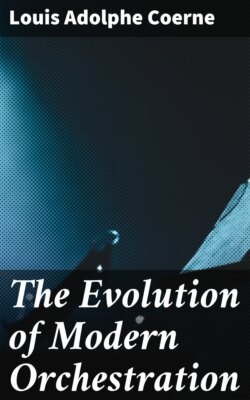Читать книгу The Evolution of Modern Orchestration - Louis Adolphe Coerne - Страница 34
II.
ОглавлениеHändel (1685-1759), the man of the world, represents the realistic, and the æsthetics of melodic form. As suzerain of oratorio, he handled the orchestra primarily as subsidiary to the voices. Unlike Bach, his influence upon organ and clavier music was small. And the value of his forty insipid Italian operas lies only in the experience it gave him in manipulation of vocal forces, and the benefits derived from keeping in touch with a cosmopolitan public. His oratorios are the composite of the orthodox style of the church, the traits of the Neapolitan School deprived of their meretricious tendencies, and a precocious expressive and dramatic instinct, the birthright of his own genius. Ultimately was added to this composite the inspiration offered by the English anthem and the talent of Purcell. Indeed, although the centripetal ideal that guided him was spontaneous and original, it must be acknowledged that in the setting of his brilliants is to be found an extraneous aggrandizement, resulting, not from eclecticism, but from plagiarism. Thus unvarnished phrases of Corelli and Alessandro Scarlatti were boldly transfused into the works of Händel when his own Muse failed him. This Italian influence betrays itself in the comparative simplicity of his modulations, and in his but moderate use of striking dissonances. The skeleton of his harmonic structures was reared on a simpler basis than Bach's; on the other hand, the massed effects of his choral polyphony have never been surpassed.
His instrumental forms were likewise Italian, and his orchestration, though masterly, was not so conspicuously original as that of his immediate great successors. Strings as the nuclei were supported by a large number of reeds. In orchestras which included twenty-five strings, frequently no less than five oboes and five bassoons would be employed. Even our modern mighty aggregation of from fifty to sixty strings would hardly bear the adjunct of ten reeds,—indeed, three oboes, one English horn, three bassoons, one contra-bassoon (eight in all) would represent the maximum if tonal equilibrium were to be preserved. However, two extenuating circumstances for this Händelian custom should not be overlooked. His method of writing for the wood did not embody those characteristics subsequently discovered by Haydn and Mozart; again, the instruments themselves lacked power. The criterion of Händel's orchestration rests almost exclusively in his oratorios. Here the mission of instrumental accompaniment was to support, strengthen, intertwine; for Händel was in quest of solidity, sonority, vitality,—terms which in this connection might be considered the synonym for the above three.
His usual method for full scoring was to double the violin parts with oboes, and the basses with bassoons. Clarinets had as yet no status; flutes added ornamentation; the brass was fully represented in logical proportion, though it was then the custom to write high trumpet parts. Next to the violins, the oboe was Händel's as well as Bach's favorite solo instrument. The organ played an important rôle in his oratorios, and he employed the harp freely for historic representations. Together with Bach, he was practically the last to make use of the theorbos. At least passing reference is due to his trios, which constitute so important a contribution to the literature of chamber music. His contrapuntal overtures and interludes, where the wood-wind are allowed greater freedom, display considerable variety. Finally, at this period the harpsichord was fortunately losing its fallacious value as a musical component of the orchestra, being retained rather as a means for conducting.
But as already stated, Händel learned to regard the orchestra not as an unenthralled entity, but rather as the chief ally of oratorio, for which the corner stone was Italian melody, the foundations comparatively simple harmonic progressions, and the superstructure the human voice, surrounded by an orchestral trellis. And the resultant was a massive tonal edifice.
